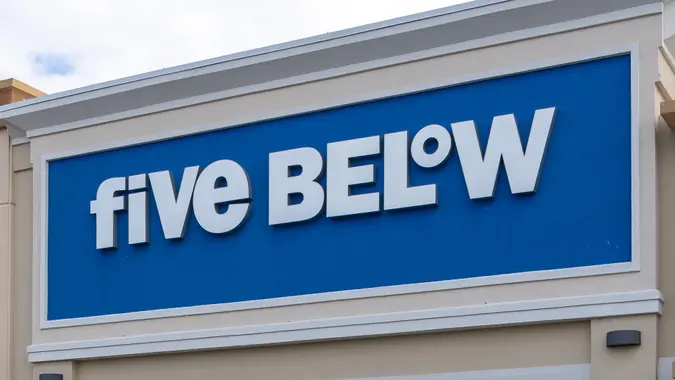How To Survive on $500 a Month: A Frugal Living Guide

Commitment to Our Readers
GOBankingRates' editorial team is committed to bringing you unbiased reviews and information. We use data-driven methodologies to evaluate financial products and services - our reviews and ratings are not influenced by advertisers. You can read more about our editorial guidelines and our products and services review methodology.

20 Years
Helping You Live Richer

Reviewed
by Experts

Trusted by
Millions of Readers
If you are living paycheck to paycheck and every month your bank account seems to drop to $0, or worse, below it, it may be time to edit your budget. With a little strategic planning and tweaking of your spending and savings habits, mastering how to only spend $500 a month can be more achievable than you think.
To limit your spending to this somewhat strict monthly amount, the first step is creating a better-fitting budget for your finances and then tracking every expense. Whether your short-term or long-term financial goals include reducing debt or embracing a simpler more frugal lifestyle, this guide will help maximize your financial resources in six key areas of your life, demonstrating how it’s possible to live well within the confines of $500 a month.
Be More Conscious With Your Grocery Bill
Food costs are seemingly at an all-time high, so any chance to edit down this necessary expense can be a clutch money move where savings are concerned. Try minimizing food and grocery costs by planning meals ahead of time, buying in bulk, choosing generic brands and cooking at home instead of eating out.
When you shop only buy things on your list to avoid impulse purchases and focus on nutritious, cost-effective foods like grains, beans and seasonal vegetables. Take advantage of discounts and coupons when shopping.
According to the USDA the average grocery bill for one person can range between $239 and $529, so clearly there is wiggle room to edit. If you get your food costs down to the $200 to $240 range you still have half of your $500 budget to spread out for other expenses.
Opt For Alternative Transportation
Though your vehicle is often your lifeline for commuting to work or running errands, there may be more options around you than you realize. If possible, use public transportation, carpool, bike or walk instead of owning or always using a car.
This can significantly reduce expenses related to fuel, maintenance and insurance as all of these costs can add up to one of your biggest monthly expenses. For example, insurance policy costs can range anywhere from $56 per month for state-minimum coverage to $176 per month for full coverage so selling your car and taking the bus can save you hundreds to thousands of dollars a year.
Having Fun Can Be Free
Entertainment doesn’t have to be expensive or even cost you anything. Your local library is a great resource to find free or low-cost activities like community events, movies, public parks, free concerts or other online resources for entertainment and education.
If you want to keep it low-key, libraries are also places where you can find a good book or two without spending a dime.
Your Healthcare Shouldn’t Cost You More Than Rent
For healthcare, look for clinics that offer services based on income. Purchase generic medications and look for essential personal care items at discount stores or in bulk. Just by switching to generic prescriptions over name brand, you can save a ton of money.
According to the FDA, generic medications generally cost between 80% to 85% less due to the lack of research and development costs associated with bringing a new drug to market. However, these medications are nearly identical when it comes to the ingredient list so why pay more?
Most healthcare experts and providers would say to opt for generic options when available as they are just as good for your health as more expensive name-brand medications, but much better for your wallet.
Only Shop For Necessities
When shopping for clothes or other necessities, thrift stores, yard sales and clearance sales can be great resources. Be disciplined about distinguishing between wants and needs. This is also where impulse shopping comes into play.
To avoid impulsive behavior, try something like the 30-day rule. This is where if you see something you like and want to buy, simply wait a month before you do. If at the end of 30 days you still want the item, then go ahead and purchase it. However, more often than not, you’ll find the desire is gone as it was merely a whim.
Fund Your Emergency Savings
Any financial advisor would say that not having emergency savings is spending without a safety net. They would also recommend that you have at least three to six months’ worth of expenses saved so you are covered in cases of financial shock such as job loss or receiving medical bills. This cushion allows you to cover your bases without spiraling into debt.
Even on a tight budget, try to set aside a small amount for savings and emergencies. This fund can be a lifesaver in case of unforeseen expenses.
Final Take To GO: Frugal Living Made Easy
The bottom line is that frugal living is about prioritizing and maximizing value in your spending, not about sacrificing. It involves being resourceful, minimizing waste and making thoughtful choices about how you use your resources.
This lifestyle isn’t about depriving yourself but rather about finding efficiency in your financial habits, focusing on what’s essential and finding creative ways to reduce costs without significantly impacting the quality of life. Frugal living can lead to increased savings, less financial stress and a more sustainable lifestyle.
Learning how to only spend $500 a month requires discipline, creativity and a little willingness to live minimally to stretch and save whatever budget you’re working within.
More From GOBankingRates
- Nearly 1 in 3 Americans Hit by a Costly Holiday Scam, Norton Survey Shows -- How To Avoid This
- Here's What the Average Social Security Payment Will Be in Winter 2025
- How Middle-Class Earners Are Quietly Becoming Millionaires -- and How You Can, Too
- The Easiest Way to Score $250 for Things You Already Do
 Written by
Written by  Edited by
Edited by 
























